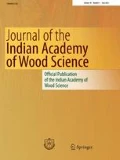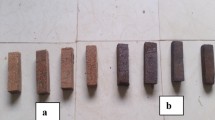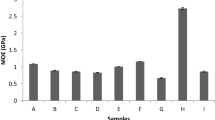Abstract
Particle board generally suffers from severe thickness swelling and water absorption which limits its utilisation such as cabinetry, table tops, shelving, wall, floor panel and in humid places such as bathrooms also. To overcome such limitation, addition of recycled PVC into the middle layer of multi layered particle board was investigated. In this study physical and mechanical property of the wood plastic particle board (WPPB) made using Poplar spp. (Poplus deltoides) particles were evaluated. The content of urea formaldehyde resin used as 10 % total weight of the particle board. For Poplar spp. (P. deltoides) particles slenderness ratio was maintained around 160–180 for face particle and around 50–80 for core particle. Addition of PVC was 10, 20, 30 and 40 % mixed with core particle to the middle layer. The multi layered WPPB were produced applying press temperature of 150 °C for 7 min of compression cycle at 24 kg/cm2 and 8 min of curing cycle at 12 kg/cm2 for the manufacture of WPPB. The boards were tested according to IS: 3087-2005 Gr II.
Similar content being viewed by others
References
Borysiuk P, Zbiec M, Boruszewski P, Maminski M, Grzeskiewiez M, Jenczyk-Tolloczko I (2001) Flat pressed wood plastic composites—mechanical and physical properties and machining capacities. In: Proceedings of the international panel and panel products symposium 2011, pp 227–231
Hu Y, Nakao T, Nakai T, Wang F (2005) Vibrational properties of wood plastic plywood. J Wood Sci 51:13–17
Jost M, Sernek M (2009) Shear strength development of the phenol–formaldehyde adhesive bond during curing. Wood Sci Technol 43:153–166
Medved S, Natasa C, Kunaver M (2011) Sorption and moisture resistance of liquefied wood bonded particle board. In: Proceedings of the international panel and panel product symposium 2011, pp 129–138
Youngquist JA (1995) Unlikely parameters? The marriage of wood and wood materials. For Prod J 45(10):25–30
Acknowledgments
The authors are thankful to Dr. C. N. Pandey, Director, IPIRTI, Dr. S. K. Nath, JD, IPIRTI and greatly indebted for the financial assistance provided by Mr. Mahesh Somu MD, M/s. DIAB Core Material Pvt. Ltd., Chennai.
Author information
Authors and Affiliations
Corresponding author
Rights and permissions
About this article
Cite this article
Thanigai, K., Sangeetha, A., Pandey, C.N. et al. Utilization of recycled poly vinyl chloride (PVC) in combination with wood particles and urea formaldehyde resin as binder to produce multi-layer particle board. J Indian Acad Wood Sci 10, 72–75 (2013). https://doi.org/10.1007/s13196-013-0096-5
Received:
Accepted:
Published:
Issue Date:
DOI: https://doi.org/10.1007/s13196-013-0096-5




